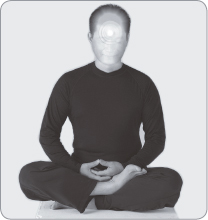
“Aung” activates the Upper Dantian. Video 8—SoundsTrue.com/MasterKeyExercises
Sea of Compassion
The World Mirrors the Heart
Xiao Yao occasionally visited other monasteries on official business or to see old friends. I liked to accompany him on these trips, which could last for days or sometimes even weeks. All the places we visited had a temple similar to ours at Jiuyi Temple, and that was always the first place my master visited when we arrived.
Xiao Yao went through the same routine each time inside the temple. First, he walked up to one of the Buddha statues. Then he meditated in front of it for a while, and then worked his way around the room, spending a few moments with all the other statues. Some temples had hundreds of statues. If we were pressed for time, he paused for only a few seconds in front of each one. But if we had more time, he closed his eyes with his hands in prayer position and remained in a deep meditative state for a long while.
I mimicked him for a few minutes. Then I grew bored and ran off to explore the temple grounds and talk to the monks. When I returned hours later, my master would still be standing in front of a statue, lost in deep concentration. I once asked Xiao Yao about the benefit of this meditation practice, and he replied by retelling the popular story about Master Foyin and the crafty scholar Su Dongpo.
Su Dongpo prided himself on his wit and liked to debate Master Foyin.
One day, over tea, he challenged the master. “Foyin, people think you are an enlightened monk, but to me you just look like a big, stinking pile of worthless dung sitting on your pillow all day long.”
Su Dongpo leaned backward and crossed his arms slyly.
Master Foyin placed his hands in prayer position. “My dear Su Dongpo, to me you look like a Buddha.”
Su Dongpo grinned and bid Master Foyin farewell.
When Su Dongpo got home, he was wearing a triumphant smile. His sister asked him what happened.
“Today I outsmarted Master Foyin,” Su Dongpo replied, then recounted the events to her.
“Oh no, brother! I’m sorry to tell you this, but you lost badly,” she said.
“What do you mean?”
“Don’t you realize that the world mirrors the heart? Master Foyin sees you as a Buddha because he is a Buddha. You see him as a pile of dung. What does that make you?”
Su Dongpo turned beet red, and then, all of a sudden, became enlightened.
Xiao Yao elaborated by explaining that he used his “temple rounds” to open his heart to each Buddha statue and merge with it. Going around the room while holding that attitude trained him to become more like Master Foyin, who experienced all people—including a mischief maker like Su Dongpo—as living Buddhas.
The third Essential Practice—Lotus Meditation—yields the same spiritual benefit that Xiao Yao derived from his temple rounds. But instead of meditating in front of a tangible statue and merging with it, you will visualize a Holy Being of your own choosing, guide it to your heart, and merge with it there. Xiao Yao taught me to do the practice by invoking the image of Guan Yin, the Chinese goddess of compassion. I still use her likeness whenever I do this meditation, but you are free to substitute her image with Mother Mary, Green Tara, Lakshmi, or any other symbol that evokes a sense of divine love. It doesn’t matter what image you choose to visualize; what does matter is that the sacred image you select arouses divine love in your heart.
Have you ever been in the presence of a special person who exudes an aura of universal love and compassion? Standing before that individual you feel safe, seemingly for no special reason. That person doesn’t need or want anything from you and their mere presence always makes you feel good. They simply love you as you are, unconditionally, without any strings attached. How would you relate back to such a person? You’d probably surrender your guardedness. Your defensive walls would come down and you’d just love them back.
Lotus Meditation slowly transforms you into that special being. As you become proficient at the practice, you are increasingly able to embody the divine love that you’re merged with, and you can express that quality in your dealings with other human beings—and not just the ones you like. The mastery of Lotus Meditation will eventually transform you into a sea of compassion. And then as you look around, you’ll see all the faces before you reflecting back beautiful Buddha smiles.
ESSENTIAL PRACTICE 3 Lotus Meditation
Lotus Meditation can be practiced while seated cross-legged on the floor or sitting comfortably in a chair. You may also practice it lying down, especially before going to sleep if you suffer from insomnia. The exercise is divided into four parts, which include:
Part 1: Chanting
Part 2: The Waterfall
Part 3: The Holy Being
Part 4: The Lotus Flower
Before we begin, I need to introduce a new tool into your Qigong repertoire, chanting. Chanting means vocalizing specific sounds that can be used to energetically activate specific parts of the body. The actual sounds don’t mean anything in particular. They are not mantras or prayers. In Part 1 of Lotus Meditation, you will chant three specific sounds designed to empower the Four Golden Wheels.
The first sound—Aung—resonates throughout your head and activates the Upper Dantian; the second sound—Ahhh—resonates throughout your chest and activates the Middle Dantian; and the third sound—Hong—resonates throughout your lower torso and activates the Lower Dantian. And when you chant all three sounds in succession—Aunnnng-ahhhhh-honnnng—you activate the Central Meridian. Let’s practice chanting in preparation for Lotus Meditation:
1. Chant, “Aunnnnng …” The sound is like “Om” but with an “ng” instead of a “m” at the end. As you chant out loud, close your eyes and feel the sound vibrate your Upper Dantian. Feel the sound vibrate your whole head: your face, eyes, ears, mouth, nose, forehead, the top of your head, the back of your head, and your whole brain. Keep your jaw relaxed as you chant. Can you feel the inside of your head tingling with Wisdom Qi? Repeat this chant three to nine times.

“Aung” activates the Upper Dantian. Video 8—SoundsTrue.com/MasterKeyExercises
2. Chant, “Ahhhhh …” As you chant out loud with your eyes still closed, feel the sound vibrate your Middle Dantian. Feel the sound vibrate your ribcage and internal organs. Feel your heart, lungs, liver, and spleen tingle and buzz with energy. Relax your chest. Try again. Go deeper. Vibrate your upper back and your spine. End the chant by focusing your awareness on your Middle Dantian. Can you feel the inside of your chest tingling with Love Qi? Repeat this chant three to nine times.
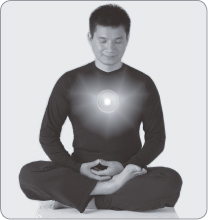
“Ahhh” activates the Middle Dantian.
3. Chant, “Honnnnnng …” As you chant out loud with your eyes still closed, feel the sound vibrate your Lower Dantian. Feel the sound vibrate your abdomen, kidneys, and sexual organs. Feel the sound penetrate deeper each time you chant. End the chant by focusing your awareness on your Lower Dantian. Can you feel the inside of your waist tingling with Vitality Qi? Repeat this chant three to nine times.
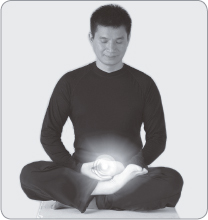
“Hong activates the Lower Dantian.
4. Chant, “Aunnnngahhhhh-honnnng …” As you chant out loud with your eyes still closed, feel the sound activate your Central Meridian and your Three Dantians. Feel the inside of your head, torso, and waist massaged internally by the streaming current of vibrating sound. End the chant by becoming aware of your Four Golden Wheels. Can you feel the inside of your whole body tingling? Repeat this chant three to nine times. Good work. Now you are ready to begin practicing Lotus Meditation.
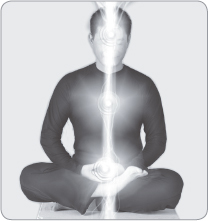
“Aung-ahhh-hong” activates the Central Meridian and the Three Dantians.
Part 1: Chanting
5. Sit comfortably on a meditation cushion or chair with your eyes closed. Put your hands on your lap over your Lower Dantian with your palms facing upward. Place the fingers of one hand on top of the fingers of the other with the ends of your thumbs touching. Relax your eyebrows, smile, and listen to a sound coming from far, far away. Part your thumbs and then gently rejoin them. This gesture signals the beginning of a new part of the meditation.
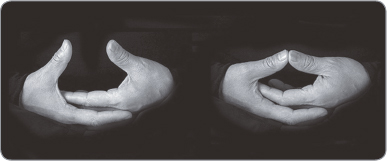
Part your thumbs and then gently rejoin them.
6. Inhale deeply, and as you exhale, softly chant, “Aunnng-ahhh-honnng …” to activate the Four Golden Wheels. Observe the vibration the sound makes in your body. Feel the qualities of wisdom, love, and vitality awaken, and feel the subtle tingling sensations spread throughout your body. Continue chanting these sounds repeatedly for at least two minutes.
Part 2: The Waterfall
In the second part of Lotus Meditation, you visualize yourself sitting under a waterfall that flows down from the sky. The pure celestial waters wash away all impurities, leaving you feeling fresh and energized.
7. Keep your eyes closed and relax every part of your body. Imagine energy filling you up like helium filling up a balloon. Feel yourself growing lighter and lighter and gradually floating upward. The winds carry you through the sky to a large green mountain with a beautiful, cascading waterfall.
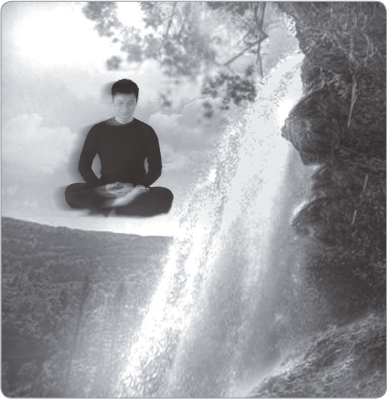
“Float” toward the waterfall like a helium balloon.
8. You settle down under the waterfall and feel the powerful jet of water streaming all over your body. The water washes over your skin, muscles, blood vessels, meridians, nerves, internal organs, and your bones and bone marrow. Feel the water wash away all impurities, leaving you feeling clean and your body, mind, and spirit returned to their natural, healthy condition. You are now completely purified, like a newborn baby, sparkling and radiating a sweet fragrance. Happiness rises up from the bottom of your heart.
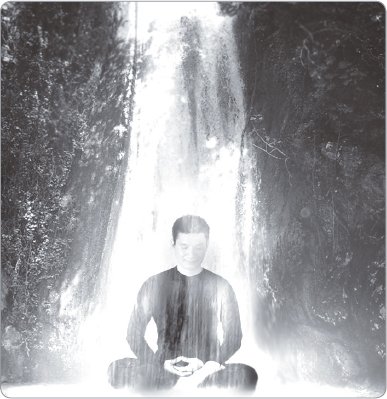
Feel the water purifying your body, mind, and spirit.
Part 3: The Holy Being
In this part of Lotus Meditation you invoke and merge with a Holy Being. You may choose the figure of a spiritual master, saint, religious figure, angel, deity, or even a figure from mythology. I will guide you through the process by referring to the image of Guan Yin, the goddess of compassion, but feel free to substitute her image with one more meaningful to you. The Holy Being can also be someone who embodies a specific quality you wish to develop, such as courage, patience, or generosity. The more you identify with this Holy Being, the more you will benefit from the practice, so choose wisely.
9. Remain seated with your eyes closed and your hands placed together on your lap as before. Now part your thumbs and then gently rejoin them. Visualize yourself sitting in a beautiful garden surrounded by flowers and birds. Guan Yin, the goddess of love and compassion, appears before you as a being of pure, shimmering light. Observe her smile, her voice, and her actions. Slowly, she glides through the air and hovers over your head. As she does so, pay attention to your long, slow breaths. As you inhale, breathe in the calming light of Guan Yin. Experience the comfort and safety this brings as you allow the light of the goddess to fill your body.

Guan Yin, the goddess of love, shines her light over you.
10. Gradually, Guan Yin begins to become smaller and smaller as well as brighter and brighter until she finally becomes a point of intense light. This light enters the top of your head and moves down your Central Meridian to your Middle Dantian. Feel the quality of love awaken in you as the point of light enters your heart. Visualize your heart transforming into an open lotus flower shining the light of love and compassion out from within.
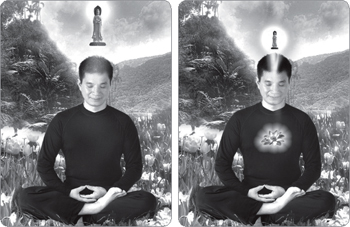
Guan Yin becomes a point of intense light and enters your heart.
11. Watch the light grow bigger and bigger. Feel Guan Yin expand until she is as big as you. You and the goddess are now merged. Your breath is her breath; her breath is your breath. Absorb her divine, loving energy into every cell of your body as this intimate connection deepens.
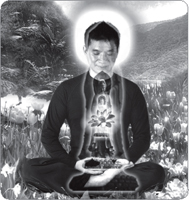
Guan Yin expands until she is as big as you; you and the goddess merge as one.
Part 4: The Lotus Flower
In Chinese culture, the lotus flower represents purity. Its natural beauty stands in sharp contrast to the muddy water in which it grows. Despite the unsightly environment where it thrives, the lotus flower retains its lustrous colors and sweet fragrance. It symbolizes incorruptible beauty: our true, divine nature.
In the final part of Lotus Meditation you visualize a lotus flower blooming within you and then you visualize yourself inside a huge lotus flower. This imagery represents the flourishing of your divine nature. As you identify with your own Buddhahood more completely, you will begin to perceive other people in this light until you eventually experience the whole universe as a reflection of divinity.
12. Remain seated with your eyes closed and your hands placed together on your lap as before. Now part your thumbs and then gently rejoin them. Visualize a lotus flower in your Lower Dantian, covered with dew and glowing brightly. Feel the blend of wisdom, love, and vitality radiate to your internal organs. Feel this energy penetrate deeper and deeper. The flower opens and closes, in sync with your breath, while emitting a sweet fragrance. This scent permeates each cell of your body and seeps into the pores of your skin. Bathe in this Divine Perfume.
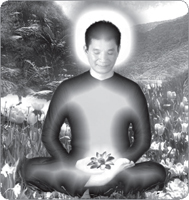
Visualize a lotus flower in your Lower Dantian and feel its fragrance fill your body.
13. Visualize the lotus flower growing larger and larger until its petals extend beyond your body. You are now sitting in the middle of this giant lotus. Soak up the peace and tranquility. Spend as much time as you wish in this special place.
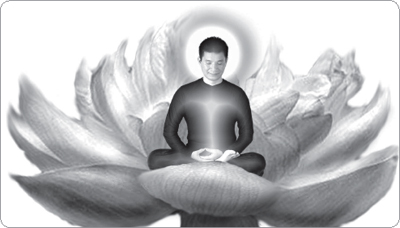
Sit inside the giant lotus and soak up the peace and tranquility.
14. Now compress all this energy into a lustrous pearl and store it in your Lower Dantian. Feel happiness rise up from deep inside your body and nourish your Qi.